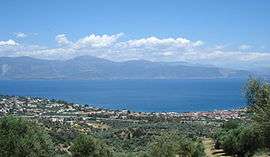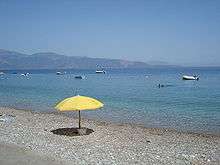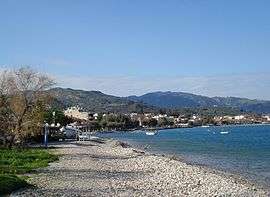Selianitika
| Selianitika Σελιανίτικα | |
|---|---|
|
Selianitika on a sunny day of winter | |
 Selianitika | |
| Coordinates: 38°16′N 22°1′E / 38.267°N 22.017°ECoordinates: 38°16′N 22°1′E / 38.267°N 22.017°E | |
| Country | Greece |
| Administrative region | Western Greece |
| Regional unit | Achaea |
| Municipality | Aigialeia |
| Municipal unit | Sympoliteia |
| Area | |
| • Rural | 2.8 km2 (1.1 sq mi) |
| Lowest elevation | 0 m (0 ft) |
| Population (2011)[1] | |
| • Rural | 902 |
| • Rural density | 320/km2 (830/sq mi) |
| Time zone | EET (UTC+2) |
| • Summer (DST) | EEST (UTC+3) |
| Postal code | 25 100 |
| Area code(s) | 2691 |
| Vehicle registration | AX , AZ |

Selianitika (Greek: Σελιανίτικα) is a coastal village in northern Achaea, Peloponnese, Greece. It is part of the municipal unit of Sympoliteia. It is located 2 km northwest of Rododafni, 6 km northwest of Aigio and 26 km east of Patras, at about 30m above sea level. The villages Selianitika and Longos (adjacent to the northwest) share a beautiful beach of fine gravel on the Gulf of Corinth which is approximately 1.5 km long. Both villages are among the most popular summer destinations of Achaea. The village had a population of 902 in 2011. The Greek National Road 8A (Athens - Corinth - Patras) passes south of the village.
Population
| Year | Population |
|---|---|
| 1981 | 814 |
| 1991 | 997 |
| 2001 | 1,147 |
| 2011 | 902 |
History
The name Selianitika is derived from the name of the village of Seliana. According to A. Fotopoulos, the descent of inhabitants of Seliana from the mountains to the coastal region of "Kryovrysi" near Aigio (where the village of Selianitika lies today) started to happen during the Ottoman period. Initially the residents of Seliana were spending the winter in Selianitika and the summer in their village of Seliana but later they settled permanently. The residents of Seliana carried with them the parish of Saint Basil (the oldest of Seliana's churches) and today Saint Basil is the patron saint of the village of Selianitika.
Tourism

Selianitika has also mineral springs [2] and a very small balneological bath spa. These sulphurous baths are recommended for diseases like arthritis and rheumatisms.[3]
References
- ↑ "Απογραφή Πληθυσμού - Κατοικιών 2011. ΜΟΝΙΜΟΣ Πληθυσμός" (in Greek). Hellenic Statistical Authority.
- ↑ List of Local mineral springs of Greece(Greek Ministry of Tourism)
- ↑ Thermal Mineral waters of Western Greece , page 36 (Stratikopoulos K. - Master Thesis - Department of Geology - University of Patras - 2007 (in Greek))
External links
- Cultural association of Selianitika "Helios" (In Greek)
- Selianitika on GTP Travel Pages
- Official website of the municipality of Sympoliteia (in Greek)
Sources
- Αθ. Φωτόπουλος, "Ιστορικά και Λαογραφικά της Ανατολικής Αιγιάλειας και Καλαβρύτων", Αθήνα 1982 (In Greek)
- K. Baedeker, "Griechenland - Handbuch fuer Reisende", Leipzig, 1893 (In German)
